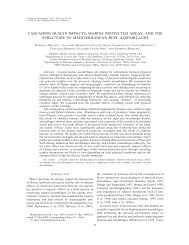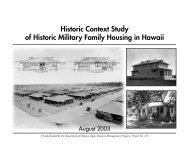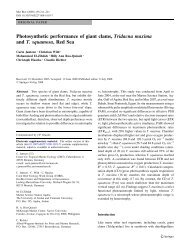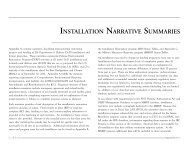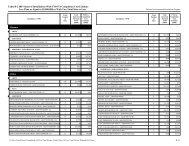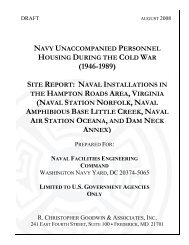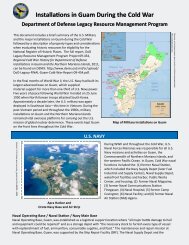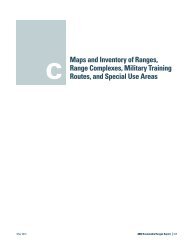Appendix M: Installation Narrative Summaries - denix
Appendix M: Installation Narrative Summaries - denix
Appendix M: Installation Narrative Summaries - denix
You also want an ePaper? Increase the reach of your titles
YUMPU automatically turns print PDFs into web optimized ePapers that Google loves.
‚��2‚����2e���2h���� f‚eg2IWWSGf‚eg2PHHS<br />
2ppshX<br />
2ƒ���X<br />
2w������X<br />
2r‚ƒ2ƒ���X<br />
2seq2ƒ�—���X<br />
2g���—���—���X<br />
2w���—2e������X<br />
€�������2„�2h—��<br />
In 1995, the BRAC Commission realigned Red River Army<br />
Depot (AD) by moving the M113 vehicle mission to other<br />
depots. In 2005, the BRAC Commission realigned Red River<br />
AD to close the munitions center and move the missile facilities.<br />
The installation retained its Bradley Fighting Vehicle, intern<br />
training, Patriot Missile, and rubber production missions. Areas<br />
of environmental concern at the depot include spill sites<br />
associated with previous industrial and pre-RCRA disposal<br />
activities. Trichloroethylene (TCE) is the main contaminant<br />
affecting groundwater at the installation. In FY95, the<br />
installation formed a BRAC cleanup team and the community<br />
formed the Red River Redevelopment Authority (RRRA). In<br />
FY96, the installation formed a Restoration Advisory Board and<br />
prepared a BRAC cleanup plan (BCP). The BCP was updated<br />
in FY01. The installation maintains a partnership with the Texas<br />
Natural Resource Conservation Commission (now known as<br />
the Texas Commission on Environmental Quality) through the<br />
Defense and State Memorandum of Agreement program.<br />
To date, the installation removed more than 2,000 cubic yards<br />
of contaminated sediment from the north and south stormwater<br />
drainage ditches in the Western Industrial Area (WIA). The<br />
Army transferred 694 acres of the 797 acres of BRAC property<br />
to the RRRA. The cleanup progress at Red River AD for FY02<br />
through FY05 is detailed below.<br />
In FY02, the installation completed the cultural resources<br />
memorandum of agreement and submitted it to the regulators<br />
for review. It closed the south lagoon and initiated the WIA risk<br />
assessment. The Army completed an inventory of closed,<br />
transferred, and transferring ranges and sites with unexploded<br />
ordnance, discarded military munitions, or munitions<br />
constituents. The inventory identified five Military Munitions<br />
Response Program (MMRP) sites at the non-BRAC, active<br />
portion of this installation. It identified no BRAC MMRP sites.<br />
In FY03, the installation completed the groundwater modeling<br />
study in the WIA and submitted the study to the regulators. The<br />
Army repaired the chrome and storm sewers by relining with<br />
cured-in-place-piping. The installation completed the Hays<br />
Plant Affected Property Assessment Report (APAR). The Army<br />
awarded a contract for the removal of the chrome beds at the<br />
industrial waste treatment plant. The installation expanded<br />
Army<br />
„ˆTPIQVPHUQVHH<br />
IWDIIQ2—���<br />
€������2�—�����—��2���2�����2��˜—�2�������D2�������2��˜˜��2<br />
���������D2�����2—���������D2—��2�����2��—�����<br />
xGe<br />
x���<br />
„gi<br />
q������—���D2����—�2�—���D2��������<br />
2p������2��2h—��X<br />
62RSFS2�������<br />
2i��F2g„g2@g���2‰�—�AX 62RSFR2�������@p‰2PHISA<br />
2s‚€Gww‚€2ƒ����2p��—�2‚s€G‚gX p‰2PHHUGp‰2PHIR<br />
2p���E‰�—�2‚�����2ƒ�—���X SE��—�2������2���2��������2���2����2����—��—����<br />
sampling at the X 1 Sewer Treatment Plant to define the extent<br />
of contamination. The Army presented its proposal to conduct a<br />
pilot study of dual phase extraction to determine the potential<br />
for removal of TCE from contaminated soils and groundwater.<br />
The regulators agreed to the proposal as a sound method for<br />
determining the technical practicability for removal of dense<br />
non-aqueous phase liquid. The Army Environmental Center<br />
analysis of the groundwater modeling projected a negligible<br />
environmental impact from groundwater discharge to Panther<br />
Creek. The installation initiated an MMRP site inspection (SI) in<br />
the active portion of the installation.<br />
In FY04, the installation completed a pilot study to determine<br />
the treatability of TCE in the groundwater, which determined<br />
that treating the TCE was not feasible using available<br />
technology. The Army removed contaminated soil from the<br />
former pesticide pit, the former Hays Sewer Treatment Plant,<br />
and the chrome drying beds. It submitted the APAR and<br />
response action completion report for these sites. The Army<br />
installed four monitoring wells offsite to determine the degree of<br />
contaminant migration from the installation. Three of the wells<br />
were non-detect for TCE and one well had detections of TCE<br />
below the action level. The installation took additional soil,<br />
groundwater, surface water and sediment samples to define the<br />
extent of contamination at the X 1 Sewer Treatment Plant. The<br />
installation completed a finding of suitability to transfer (FOST)<br />
approximately 14 acres. The Army submitted release<br />
investigation reports for the former diesel transfer station at<br />
Building 172 and the Industrial Waste Treatment Plant. The<br />
Army added two MMRP sites to the inventory.<br />
In FY05, the installation completed a soil remediation project at<br />
the former Incinerator Building 722. In addition, the installation<br />
awarded a performance-based contract for achieving response<br />
complete at 14 contaminated sites. The Army submitted a<br />
corrective measures implementation plan to the State for the<br />
closed hazardous waste landfill. The installation completed a<br />
draft SI and historical record review reports for MMRP sites.<br />
p‰HT2s‚€2€�������<br />
The Army completed APARs for Buildings 371 and 373, used<br />
oil tanks, and the X 1 Sewer Treatment Plant. Red River AD<br />
completed response action plans (RAPs) for Buildings 371,<br />
373, 1027, the used oil tank facility, and the X 1 Sewer<br />
Treatment Plant. The installation implemented the groundwater<br />
monitoring plan for the closed Ordnance Training Center<br />
hazardous waste landfill. The installation also completed two<br />
FOST documents, totaling 38 acres for future transfer of this<br />
property to the RRRA. The cost of completing environmental<br />
restoration has changed significantly due to technical issues<br />
and changes in estimating criteria.<br />
p‰HT2ww‚€2€�������<br />
Red River AD submitted the SI report and received regulator<br />
comments.<br />
€�—�2��2e����<br />
Plan of action items for Red River Army Depot are grouped<br />
below according to program category.<br />
22222s‚€<br />
0 Complete X 1 Sewer Treatment Plant<br />
remediation project in FY07.<br />
0 Construct biowalls to protect Panther Creek<br />
from contaminated groundwater in FY07.<br />
0 Submit RAP for Panther Creek sediments in<br />
FY07.<br />
0 Submit RAP and APAR for WIA in FY07.<br />
0 Complete the environmental condition of<br />
property and CERFA reports for the BRAC 2005<br />
parcel in FY07.<br />
0 Implement groundwater monitoring plan for<br />
Buildings 371, 373, 1027, the WIA, and the<br />
used oil tank facility in FY07-FY08.<br />
0 Implement RAP for Buildings 371, 373, 1027,<br />
the WIA, the used oil tank facility, and the<br />
X 1 Sewer Treatment Plant in FY07-FY08.<br />
22222ww‚€<br />
0 Initiate RCRA investigations at seven MMRP<br />
sites in FY08.<br />
„��—��—�—D2„��—�<br />
M-170




